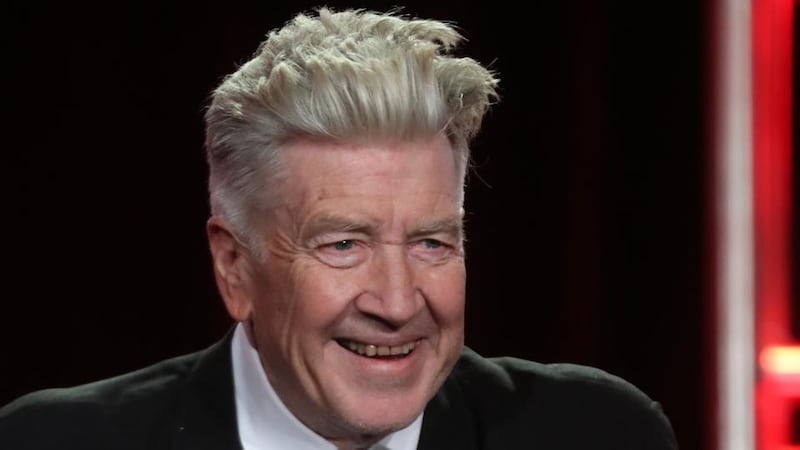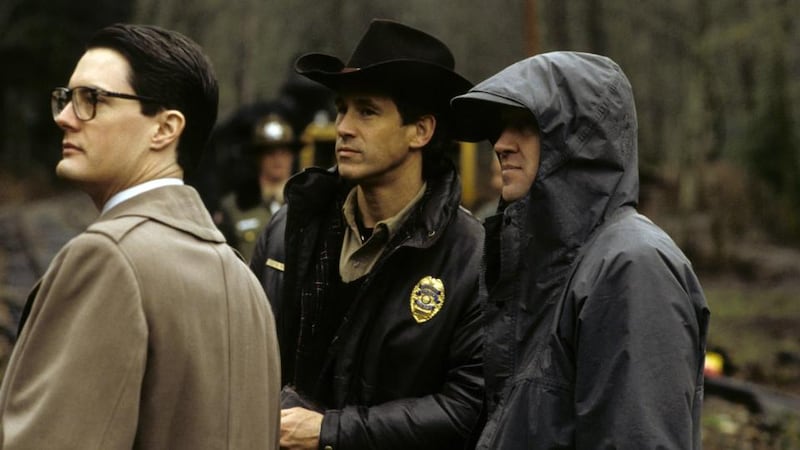Who killed Laura Palmer? This is the question that animates Twin Peaks, David Lynch and Mark Frost's game-changing TV series from 1990. With its mysterious eight-episode first season, Twin Peaks proved that prime-time television could be just as dramatic, ambiguous and stylish as art-house cinema. Lynch and Frost turned a simple murder mystery into a surreal and poetic examination of American popular culture and, in doing so, provided a blueprint for the open-ended, character-driven, big-budget television dramas that would follow in its wake.
Twin Peaks is a remote town in the pacific northwest of the United States, a wholesome, straight-shooting place on the Canadian border, surrounded by tall Douglas fir trees. Palmer was a local high school student – a blonde, beautiful, homecoming queen, popular and sweet as cherry pie. When she washes up on a river bank, wrapped in plastic, the investigation into her murder opens up a pathway into the secret life of the town and its community. It turns out Twin Peaks is a town with a lot to hide.
The person leading the investigation is FBI agent Dale Cooper, played by Kyle MacLachlan. Cooper is basically an idealised vision of law enforcement, the law in question being more cosmic than federal. Justice, in the purest sense, is his goal. If he can have a damn fine cup of coffee and some pie along the way, all the better. Cooper is a masterful interpreter of signs and visions, led as much by his dreams as the physical evidence. For the viewer, the dreams would seem to be just a significant.
American Dream
More than almost any other television show, Twin Peaks is concerned with the American Dream. It takes those two words and puts them together as a psychoanalyst would: poking at them, turning them over, seeing what lies beneath. Twin Peaks works with the raw material of American dreams, of a dreamed America: blonde waitresses and beauty queens, tough-but-fair sheriffs in cowboy hats, vast and mystical landscapes. A 1968 Datsun pickup, powder blue, or the roar of a Harley beneath a solitary traffic light on a moonless midnight road. (It is no surprise that the show has its deepest roots in a project about Marilyn Monroe.)

These kinds of symbols form a shorthand for American culture – not a social or political culture exactly, but more what the French philosopher Jean Baudrillard called "astral America". The United States as it imagines itself, the mythos from which it draws the glue that holds the whole crazy apparatus together. I guess it's whatever people mean when they say America could be made great again.
It's a theme picked up years later by Mad Men, with Don Draper's journey functioning as a lens through which to examine what goes into the myth of the self-made man, of so-called "manifest destiny": the pain, the exhaustion, the apathy, all that fabulous wreckage such a man leaves in his wake. Mad Men has a cynical, if not unrealistic ending, but Twin Peaks, being far more dreamlike, has no ending at all. It just stops at a terrifying moment, questions unanswered. Suddenly you're not there any more.
What America demands, like any dream, is interpretation and everything in Twin Peaks is open to that. Owl-eyed fans are invited to turn over every bit of information, every image, every hint of a clue in the hopes of unlocking something like a coherent meaning. But there is no coherent meaning, no true guiding hand, and this is what makes the first series in particular so special. The mystery of who killed Laura Palmer has, for those first eight episodes at least, no answer. It isn't just that the answer isn't revealed; it's that the show genuinely has no answer. This creates a void at the heart of the action, a blank and silent mirror which reflects and magnifies the audience's pre-existing fears and assumptions.
It's a trick that the first season of True Detective tried to pull off and it is telling that it failed for much the same reasons as the second season of Twin Peaks. Few shows have sent its audience down as many intellectual rabbit-holes as season one of True Detective (perhaps Lost takes first prize in this category), but as soon as the clues begin to focus on an actual villain, interpretation becomes mere investigation and the joy goes out of it. Once True Detective realised it had to solve the mystery, its innovative formal structure disappeared and we were left with nothing but bad plotting and overwrought dialogue.
While True Detective capitulated into a bland shoot-out with a man in a mask, Twin Peaks retains its power to shock and terrify right to its final moment. Bob, a demonic, interdimensional spirit, is the avatar of the show's horror. He is terrifying both as an image – Frank Silva's face, his animalistic movements, and his unhinged power are all incredibly disquieting – and as an idea. Bob needs a human host to be in our world; he could be hidden inside anyone, lurking within even our most intimate relationships. He's a killer and a rapist, someone who takes intense pleasure in the pain of others, who feeds on fear. He is a master of physical, sexual and psychological abuse.
One of Cooper's FBI colleagues describes Bob as "the evil that men do". It's as good a description as any for the horror that haunts Twin Peaks: a timeless and disembodied force, latent beneath the placid surfaces of our everyday lives, which intermittently coalesces into shocking displays of violent power. This is the dark side of the dream, the needling history of abuse and violence that constitutes a major, even dominant catalyst in the long story of American nationhood. If you were looking for the roots of The Sopranos, you might find a hint of that complexity right here in Twin Peaks. Beyond the truly cinematic aesthetic of these shows, there is a moral ambiguity in both that understands any explicit duality of good and evil to be a sham.

The long-rumoured third series of Twin Peaks premieres in the US on May 21st. It consists of 18 hour-long episodes, with Lynch as sole director. It's an interesting time for the show to return. The original series, in keeping with Lynch's work of the time, displays a kind of postmodern logic that foregrounds the viewer's ability to interpret, and deferred any sort of cohesive "message". There is no fixed meaning to be found: you have to make your own sense of it.
It doesn't take a genius to see how this idea has become both more real and more dangerous in the 27 years since Twin Peaks first appeared. The quality and value of facts is at an all-time low; language is debased and ever more abstract. Interpretation is a necessary art form now, and radical ambiguity is basically the day-to-day norm.
Subversive
Even just on the level of television, things have changed. Twin Peaks made the case for more adventurous and ambiguous TV in 1990; it returns when the fruits of that experiment have become almost normal, almost expected. Cinematic budgets and auteur directors are not so rare now. Hordes of obsessives discuss innumerable theories online every day. How does a modern-day Twin Peaks function, how does it stay mysterious and subversive, in this kind of environment?

If the reboot is to succeed, it will have to do more than reheat old references for the fans to pore over. The scant previews we've seen suggest a new generation discovering an old evil for themselves; the journeys of these characters, rather than the familiar faces, will likely determine the success of the series. Happily, from Blue Velvet to Mulholland Drive, Lynch has always excelled at dramatising the loss of innocence.
Whether the new series holds up to the original run is basically unimportant: it might take 10 or 20 years to know for sure. What matters now is whether Lynch can lay his hand on the symbols that signify normality and its opposite in America today.
Lynch once described Twin Peaks not as a place, but a condition. The question in every fan's mind now is whether he can once again find such distinctive images, such an unmistakable mood, to convey the symptoms of that condition. The story, as ever, is in the telling. As Hawk tells a dazed Agent Cooper in the second season: "You're on the path. You don't need to know where it leads. Just follow."
The new season of Twin Peaks begins on Sky Atlantic at 2am on May 22nd


















